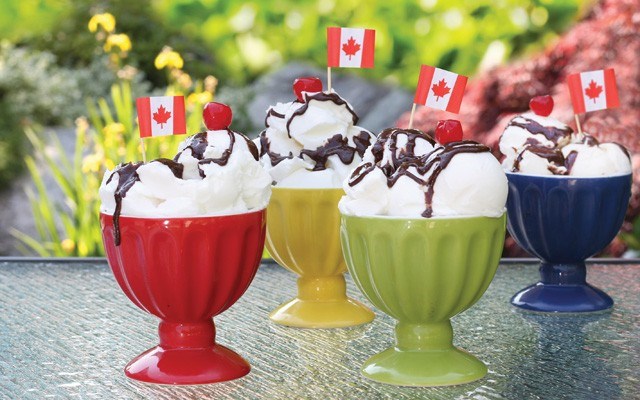Hey, hey — It's Canada Day, eh? So get out the ol' red and white, and celebrate.
Food-wise you can go patriotic all the way on July 1. To start, Nesters' Market is featuring all kinds of Canadian products this week, including Chapman's Canadian Vanilla, eh!, replete with a giant red maple leave smack dab in the middle of the block of sparkling white vanilla. And, yes, Chapman's is all-Canadian, started by David and Penny Chapman in a wee town near Georgian Bay, Ont., back in the 1970s.
You can go for some Rogers Sugar, B.C.-made, in its distinctive white bag with the little clusters of red maple leaves — sugar refined since 1890 in the province's oldest industrial site, an imposing old brick warehouse on Vancouver's waterfront just off Powell Street. It's also the largest sugar refinery in Canada, with an atmosphere so rich and authentic it's been used in 100-plus film productions.
A lot of people think Canadian cheddar cheese is a distinctive national food treasure, and it is in its own right. Although it originated in Cheddar in southwest England in the 12th century, it was Brits and Loyalists from America who introduced cheddar-making to the early Canadian colonies.
Cheddar's provenance along with all of the Canadian cheeses we cheeseheads love has an authentic bilingual connection. Samuel de Champlain brought the first milk-producing cows to Canada from France. So on Canada Day who wouldn't want some of those typical and typically delicious semi-soft cheeses coming out of Quebec? Please pass the Oka.
You can't go wrong, either, with great Canadian bacon. Our distinctive back bacon is a big hit with tourists. Plus there's the greatest Canadian bacon, ever (at least in our family's opinion) — Harvest bacon made by the Propp family in Yorkton, Sask.
Besides all the great Canadian products at your favourite grocery store, you can boost your Whistler-style Canada Day with a treat very close to home.
Gather at the Town Plaza Gazebo at 1:15 p.m. to hear from Whistler's mayor, Nancy Wilhelm-Morden, and local MLA, Jordan Sturdy. Then sing "O Canada!" in perfect harmony before digging into some perfect maple gelato from Whistler's own Lucia Gelato. This sweet treat is as Canadian as it gets, made with some of that real B.C. Rogers Sugar, two full litres of maple syrup from the Steeves family, pioneers in New Brunswick in the 1700s, and plenty of fresh milk and cream from Dairyland, which started as the marketing arm of a B.C. dairy farmers' cooperative.
If you don't get your fill of free maple gelato, simply walk over to Lucia Gelato's new store across from the Olympic rings in Olympic Plaza. From there it's a hop and a skip to the Squamish Lil'wat Cultural Centre, where you can sample all kinds of original, true Canadiana — aboriginal fare like Squamish salmon chowder, Lil'wat venison chili and some fresh bannock bread.
After all, it was First Nations people, of course, who sustained themselves in this fair land long before Europeans arrived, by sourcing everything from nature. It's a tough concept to grok today, whether celebrating our Canadian-ness or not, as habituated as we are to grocery stores. Something like our bruin friends getting habituated to easy-peasy food sources when everything they naturally eat is in the wild.
So what do you eat when there's no Save-On down the road?
"You eat whatever you can," says Whistler Museum's programs manager, Jeff Slack, who did his masters in environmental history in B.C.
You eat all kinds of berries from meadows and forests: salmonberries, thimbleberries, blueberries, huckleberries, raspberries, brambleberries, blackberries and salal berries, maybe cloudberries that grow so close to the ground. Saskatoon berries, fresh and dried. Indian plum berries, when they're fully ripe. Red elderberries, when they're cooked (not raw). Rose hips for tea.
You eat edible roots and tubers. Yellow glacier lily, spiny wood fern, wapato, nodding onion, wild sweet potatoes, wild carrot, bear root, sweet vetch and balsamroot, to name a few.
You eat meat from animals and birds, hunted and trapped, large and small. Fish, plenty of fish, from lakes, streams and rivers. Salmon from Howe Sound. Animals useful for fur also yield food. Beaver, greasy as it is, was excellent fuel for the calorie-burning lifestyles of First Nations and pioneers. Deer; moose, rare though it is; ground squirrels; even porcupines. Delicious ptarmigan and waterfowl.
John Millar, an early pioneer in Whistler Valley, namesake of Millar Creek and reputedly on the lam after killing a couple of people in Texas, was known for serving muskrat stew and Stellar's jay pies to people overnighting at his place en route along the Pemberton Trail. It originally wound from the Chilcotin Plateau to Vancouver, connecting the gold-rush fields to the coast.
As for First Nations people, their wild food resources were proprietary and managed, says Jeff. "They had management systems in terms of people owning certain resources. Families might have had rights to certain fishing spots... and you had to respect old familial properties and territories.
"Same with berries," he says. "There's lots of research that indicates berry crops were managed quite actively. It was more localized and more deliberate than just setting fire to the woods and hoping berries grow back. Most scholars would say it was definitely cultivation bordering on agriculture."
Wild food, cultivated food, store-bought food, homemade food. A cornucopia of Canadian goodness is out there, just waiting for you to discover it.
Happy Canada Day!
Glenda Bartosh is an award-winning journalist who always thinks of grilled cheese sandwiches as real Canadian food.




